Edazumi
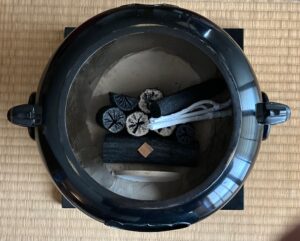
Sumi-bi, 炭火, charcoal-fire, set in a ki-men bu-ro, 鬼面風炉, demon-face wind-hearth, showing the placement of the white eda-zumi, 枝炭, branch-charcoal.
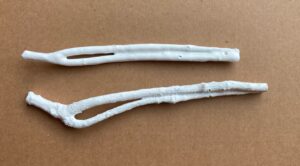
Eda-zumi, 枝炭, branch-charcoal coated with go-fun, 胡紛, foreign-flax, kai no kona, 貝の粉, shell’s powder.
Edazumi for fu-ro, 風炉, wind-hearth: L. 5 sun kane–jaku, 15 cm. begins with three pieces of edazumi in the sumi-tori, 炭斗, charcoal-measure, but only two pieces of edazumi are put into the furo. One piece remains in the sumitori.
Edazumi for sunken ro, 炉, hearth: L. 5 sun kujira–jaku, 19 cm. begins with five pieces of edazumi in the sumi-tori, 炭斗, charcoal-measure, but only four pieces of edazumi are put into the ro. One piece remains in the sumitori.
Pieces of edazumi are added to the sumi-bi, 炭火, charcoal-fire, in the furo and in the ro. Although the edazumi for ro are larger than the edazumi for the furo, they both measure 5 sun.
It should be understood that the lengths of the charcoal pieces for furo are measured with the kane-jaku and ro charcoal pieces are measured with the kujira-jaku. The classic ratio widely manifested in Chanoyu is 8:10. The ratio between the edazumi for furo and ro is not 8:10, although it is very close, 8.3333:10. One must be aware of ideal measurement.
Urasenke illustrations of furo sumi te-mae, 手前, hand-fore, show that two pieces of edazumi are put into the hearth with one piece remaining in the sumi–tori, 炭斗, charcoal-(measurement) holder. The two edazumi pieces added to the furo may represent the Kanji, futa, sō, 双, pair, as the branch charcoal resemble the Kanji.
The azalea branch is composed of a main branch with an off-shoot branch, and so that there may two measurements: the main branch is 5 sun kane-jaku, and the off-shoot branch is 4 sun kane. Therefore, the two branches relate to each other 4 to 5, or 8 to 10, yata, 八咫, eight-span, infinite vastness.
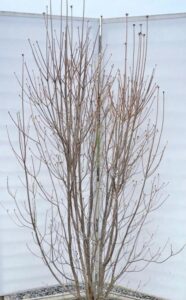
Leafless living azalea shrub beginning to bud. Note two and three branching of the twigs.
Tsutsuji no eda, 躑躅の枝, azalea’s branch, Kanji usually written in Katakana, ツツジ, .
Tsutsuji-moku, ツツジ目, ‘azalea’-class; Ericales are a large and diverse order of dicotyledons, including for example tea, persimmon, blueberry, Brazil nut, and azalea. The order includes trees and bushes, lianas, and herbaceous plants. Together with ordinary autophytic plants, the Ericales include chlorophyll-deficient myco-heterotrophic plants and carnivorous plants (e. g. genus Sarracenia). Many species have five petals, often grown together.
A possible wordplay on tsutsuji could be tsū-tsuji, 通辻, through-crossing, might be evoked by the form of the edazumi.
Edazumi are made of the twigs of tsutsuji, 躑躅, azalea, with two or three tines, they are made into charcoal before they are covered with ht: 400;”>gofun. The twigs are left black for special use such as in the 10th month. It should be noticed that the tip ends of the twigs are joined together, which is often achieved when the gofun is applied. It appears that the intention is make the edazumi resemble matsu–ba, 松葉, pine-leaves, needles.
During the building and rebuilding of the charcoal fire, the charcoal pieces, including the edazumi, are handled with pairs of hi-bashi, 火箸, fire-rods. The form of a pair of hibashi may also be likened to two-tine pine needles.
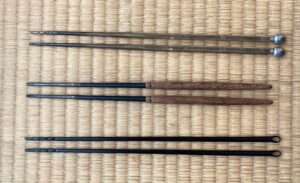
Hi-bashi, 火箸, fire-rods: top – pair of kazari hi-bashi, 飾火箸, display fire-rods; brass with shichi go san, 7, 5, 3 (七五 三), grooves with silver heads in the form of gin-nan, 銀杏, silver-apricot, Hōunsai choice.
Middle – pair of blackened steel hollow rods with kuwa, 桑, mulberry, wood handles; choice of Rikyū, used with the sunken ro, 炉, hearth.
Bottom – pair of blackened steel hollow rods with eyelet heads; choice of Rikyū, used with the portable fu-ro, 風炉, wind-hearth.

Naga hi-bashi, 長火箸, long fire-rods, for furo, with bamboo ruler marked with kujira-jaku, 鯨尺, whale-span.
Naga hi-bashi, 長火箸, long fire-rods, used primarily out of the view of guests and used as work tools associated with the mizu-ya, 水屋, water-room. The length is one shaku kujira-jaku, equal to 38 cm.

Stylized motif of a two-tined pine needle, with exaggerated saya, 鞘, sheath. The design resembles the Kanji for dai, 大, great, on its side. Also, there is a resemblance to a human stick figure.
Evergreen pine needles are emblems of sue-hiro, 末広, end-wide, and symbolic of Infinity in Space, as they spread out from a single point. When the tines are joined or when one tine is broken and crosses the other showing the end of infinite. Life is temporal.
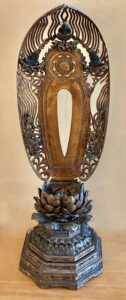

Left: the profile of the halo, kō-hai, 光背 ,light-behind, of Amida is in the shape of a boat to sail to the Western Pure Land. Called, hi-gan, 彼岸, that-beach, which is another name for Nirvana. Also, the center of the halo is open, which implies that there are two ways to reach the Pure land. One is to practice Mahayana Buddhism to attain Wisdom and Compassion and ultimately Nirvana, the other is to practice Pure Land Buddhism and recite the nenbutsu to attain Nirvana. Both paths ultimately lead to Enlightenment, or the Western Shore of Paradise.
The pointed halo in its entirety is called the funa-gata kō-hai 舟形光背, boat-shape light-behind. The nimbus of the round aspect of the head is called zu-kō, 頭光, head-light. The nimbus of the body is called shin-kō, 身光, body-light.
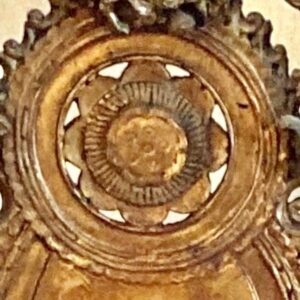
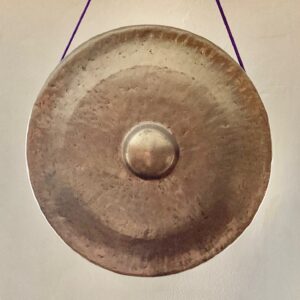
Zu-kō, 頭光, head-light; the halo behind the head of Amida. The zukō is in the form of an eight-petal lotus. From a Vedic perspective, the eight petaled lotus is present in the energy body and is called hridaya. It is the ‘cave of the heart’ and is the area in which the entire universe is held in seed form. The eight petaled lotus is the place where it is possible to move consciousness from the individual to the universal. Abiding consciousness in this location is said to bring Nirvana.
The lotus-form is found on temple bells, kan-shō, 喚鐘, call-bell, is where the bell is struck. The dora is similar in shape, and is struck on the central knob. The kanshō was used to beckon guests back into the tea room for Tea. The striking pattern for four guests is Dai Sho Chū Chū Dai, 大小中中大, Great Small Middle Middle Great. When there are more than four guests, two strikes are added at the start: 大小大小中中大 . There is the remotest possibility that the five strikes may represent the five syllables of A-mi-da Bu-tsu, and the seven syllables may represent the seven syllables of the Nen-butsu, 念仏, Wish-Buddha; Na-mu A-mi-da Bu-tsu, 南無阿弥陀仏, South-not Praise-increase-steep-Buddha.
The word namu has roots in the Sanskrit word found in namaste, which welcomes the Buddha. When enacting namaste, both hands are held together upright without the palms touching, leaving an opening. This mudra may be likened to a piece of edazumi.
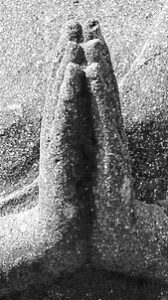

Left: Anjali Mudra the non verbal symbol of welcome and honoring the moment.
Right: Edazumi

Three-branch edazumi. Made for both furo and ro. This style of edazumi is employed by various schools of Tea.
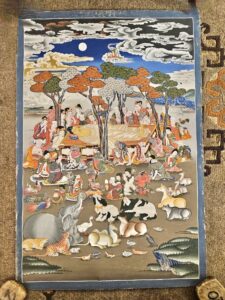
Painting of the death and Nirvana of the Buddha, showing four green living trees, and four yellow ‘dead’ trees surrounding his bed. This image may be one of the foundations of the origin of the tokonoma. The four corner hashira, 柱, posts, of the tokonoma. The Kanji for hashira is used to count deities.
The white two-tined edazumi may represent the Sa-ra sō-ju, 沙羅双樹, Sand-spread twin-trees, which surrounded the bed of the Buddha as his death and Nirvana, Ne-han, 涅槃, Humus-tub, transition into paradise.
When Shakyamuni Buddha died at the age of eighty, there were two sal trees on four sides of the bed rest. It is said that one of the two trees died due to the sadness of the Buddha’s disappearance, and it is also said that they died white with the extinction.
The Kanji for white, 白, is said to represent the finger nail of a corpse. A corpse of a Buddhist or Hindu is dressed in white cloth. White is the color of mourning as well as purity. White is symbolic of grieving within Buddhist tradition, thus white funeral apparel is an appropriate sign of respect and mourning for the deceased.
There is the remotest possibility that the edazumi represents a person or corpse. The Kanji for person is hito, nin, 人 , human being.
The ash bed in the furo is shaped into ni-mon-ji, 二文字, two-character-letter, may represent the Nirvana bed of the Buddha, and toko, 床, of tokonoma also means ‘bed’. The Kanji, 床の, tokono, is composed of moku, 木, tree, and hidari, 左, left (side).
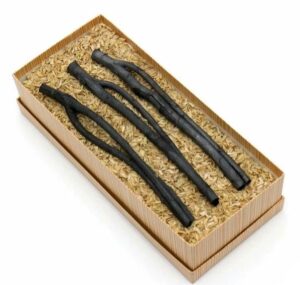
The edazumi that are left in their charcoal state without being covered with gofun, called kuro eda-zumi, 黒枝炭, black branch-charcoal. The black edazumi is used variously in different schools of Tea. Note that all edazumi usually is packaged in sukumo, 糘, rice hulls, to prevent damage.
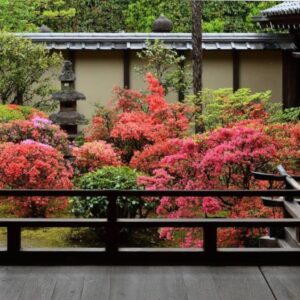
Tsutsuji is written with the Kanji, 躑躅: teki, tachimotoeru, 躑, squat, sit on heels, squat, and taku, 躅, tap with feet, hesitation. But the etymology is derived from the Japanese saying: “the azalea is so beautiful that the viewer stops.”
The azalea flower has five petals, originally yellow, and three leaves. The azalea plant is very familiar in gardens and especially in Buddhist gardens. The plants are trimmed to form rounded mounds, and when in full bloom, the entire surface may be covered with flowers.
The azalea is a type of flowering shrub. The name was coined by Linnaeus in 1753, after Modern Latin, from the fem. of Greek azaleos, dry, related to azein, to dry up, probably from root as, to burn, glow, because the plant thrives in sandy soil.
Chinese medicinal use of the azalea: the flowers are analgesic, anesthetic, and sedative. They are applied externally in the treatment of arthritis, caries, itch, and traumatic injuries. The root is used in the treatment of arthritis, rheumatism, and traumatic injuries. The plant on its own is very toxic, and as such is not used as chabana, however, when used medicinally it is beneficial. Medicine in Buddhism is under the protection of Yaku-shi Nyo-rai, 薬師如来, Medicine-master Like-become.
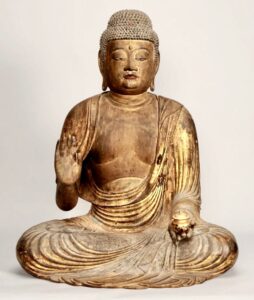
Image of Yaku-shi Nyo-rai, 薬師如来, Medicine-master Like-become.
Yakushi benefits humanity with physical and spiritual well-being: two-branches, Go-rin, 五輪, Five-rings, which is associated with the physical, and Go-gyō, 五行, Five-transitions, which is associated with the spiritual, are united in the one goal of health.
Edazumi represents the healing plant of Yakushi, who may in a way emulate the Buddha twirling the lotus during what is now known as the Flower Sermon. The twirling of the flower culminates in the ultimate realization of the Void, as represented by the three pieces of byaku-dan, 白檀, white-sandalwood, in the kō-gō, 香合, incense-gather. Yakushi’s ‘medicine’ is held in the covered jar held on his up-turned left hand, which is, in part, the origin of both the kōgō and cha-ki, 茶器, tea-container.
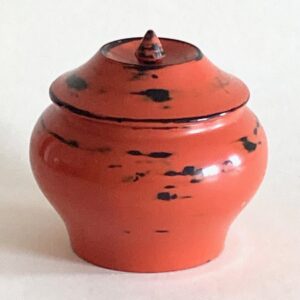
Cha-ki, 茶器, tea-container in the form of a ya-kki, 薬器, medicine-container, turned wood with abraded vermilion lacquer in the style of Ne-goro, 根来, Root-become.
Yakushi Nyorai, when creating medicines, employs fire to heat various ingredients. When building the charcoal fire it is possible to consider the representation of Yakushi’s hand. The shitabi could be his palm, the five pieces of charcoal that are added could be his fingers. The edazumi could represent something that Yakushi holds between his thumb and forefinger. Yakushi holds the medicine container on his left palm, or at times holds a branch of the myrobalan, a plant with strong medical powers, also known in Japanese as mirobaran.
Myrobalan is part of the families of the three major fruits used in Ayurveda, the traditional Indian healing practice, and is used as a medicine to prevent aging and prevent disease. Often, the plant that Yakushi holds in his right hand is identified as a branch with fruit, or flowers, that have strong medical powers.
The yakki held by Yakushi is fabricated by human beings, whereas the myrobalan is a living thing from nature.
Yakushi Nyorai is accompanied by Gakkō, 月光, Moon-light, and Nikkō, 日光, Sun-light. It is possible that the edazumi represent the moon and the sun.
Below are the early characters for evolution for the Kanji for the sun and the moon. The early characters for the moon somewhat resemble the edazumi.

Top line: shows the progression of development of the Kanji for the sun.
Bottom line: shows the progression of development of the Kanji for the moon.
The moon is Tai-in, 太陰, Great-Yin, and the sun is Tai-yō, 太陽, Great-Yang. The Kanji for the moon and sun is combined to form the Kanji, 明, which is read myō, meaning Buddhist, Vidya [wisdom]; akira, etc., and meaning bright, light, tomorrow, etc. It can also be read as Mei, meaning god, deity, insight, vision, etc. Min, Ming dynasty of China.
Kanji for nichi, 日, sun, is square and may be likened to the square of the byakudan. It is said that the Buddha was cremated on a pyre of byakudan. Amida Buddha’s name means Infinite Light.
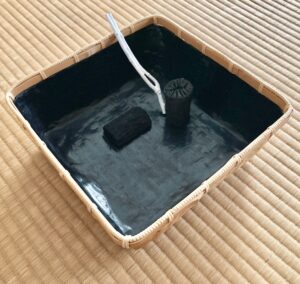
Sumi-tori, 炭斗, charcoal-measure; Rikyū recommended using as a sumi-tori, a square bamboo sai-ro, 菜籠, vegetable-basket. The most familiar sumitori is a bamboo basket lined with black paper and showing the two pieces of charcoal that remain in the basket after the charcoal has been put in the furo. One piece of edazumi is left in its place in the basket.
The half-round wari-gi-tchō,割り毬杖, divided ball-strike, is called the makura zumi, 炭,枕, pillow charcoal, and may represent the moon. The maru-gi-tchō, 丸毬杖, round-ball-strike, standing upright, is called the kōgō-dai, 香合台, incense-gather-support. It may be likened to the sun. Likening the charcoal to the sun and the moon, may identify the edazumi as representing the Ama-no-gawa, 天の川, Heaven-’s-river. In addition, the edazumi may represent the smoke trail of burning incense.
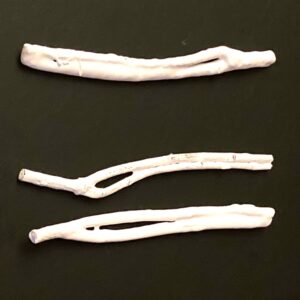
Three pieces of edazumi are carried in the sumitori, and only two pieces are put into the furo, with one piece remaining in the sumitori. With its black paper lining the sumitori holds representations of the sun and the moon that, if added to the fire, would turn red and finally white when burnt out. This may represent the gloaming, the evening light. When the Buddha died and entered Parinirvana, the full moon was rising in the east, while the sun was setting in the west.
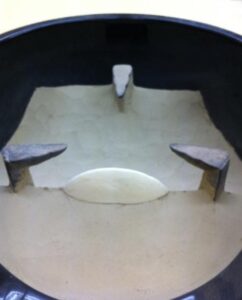
Furo hai-gata, 灰形, ash-shape, ni-mon-ji, 二文字, two-character-letter, with two parallel horizontal ridges of ash. The three tsume, 爪, talon, of the go-toku, 五徳, five-virtues, rise out of the ash. Only the top of the white crescent of the mae-kawarake, 前土器, fore earth-container, is centered between the two front talons.
During the building of the charcoal fire in the furo, a small crescent tsuki-gata, 月形, moon-shape, of ash is spooned from the front surface of the ash, and is let fall on the back surface of the ash. The mae-kawarake may represent the moon. The charcoal fire in the furo may represent the cremation and Parinirvana of the Buddha. When he was dying, the Buddha told others to place his bed in the grove of twin sal trees so that his head would be directed toward the north, and that he would lie so that he would face west toward the setting sun, Amida’s Western Paradise.
If the dō-zumi, 胴炭, body-charcoal, represents the body of the Buddha, with its head to the left, North, then the mae–kawarake might represent the setting sun in the West. The moon-shaped ash spooned from the front of the ash is placed at the back of the ash bed, thus placing the moon in the ‘East’. The moon was full when the Buddha died, so the small amount of ‘moon’-ash moved from the ‘West’ to the ‘East’ may represent the rising full moon.
For further study, see also: Charcoal Sumi for Furo or Ro, Kami Kama Shiki and Kaishi, and Pine Needles in Tea and Zen

